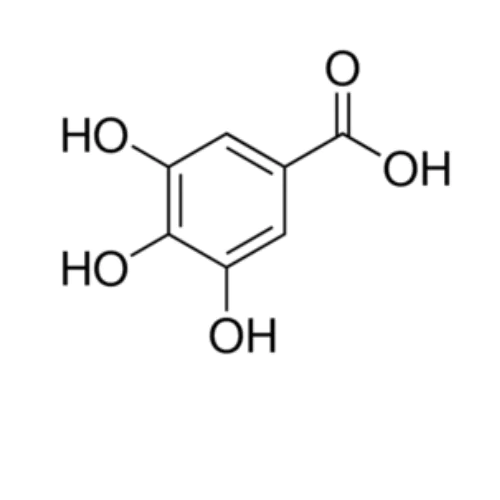Synonyms: 3,4,5-Trihydroxybenzoic acid, Gallate, 3,4,5-Trihydroxybenzoate
Cas No. 5995-86-8
Molecular Weight: 170.12
Description:
Gallic acid is a naturally occurring organic compound that belongs to the group of phenolic acids. It is derived from the hydrolysis of tannins and can be found in a variety of plants, including oak, sumac, tea, grapes, and berries.
Gallic acid can be obtained from:
- Oak bark and gallnuts (a plant gall caused by insects)
- Tea leaves, especially green tea
- Various fruits, such as grapes, strawberries, and raspberries
- Certain herbs and plants like sumac and pomegranate
Functions & Health Benefits:
- Antioxidant Properties: Gallic acid is a potent antioxidant, meaning it helps neutralize free radicals and reduces oxidative stress, which can contribute to aging and various diseases.
- Antimicrobial Effects: It has shown antimicrobial activity against various pathogens, including bacteria, fungi, and viruses. This makes it useful for applications in medicine and food preservation.
- Anti-inflammatory: It can inhibit the production of pro-inflammatory molecules, making it useful in reducing inflammation and potentially helping with conditions like arthritis.
- Potential Anticancer Properties: Some studies suggest that gallic acid might have anticancer effects by inducing apoptosis (cell death) in cancer cells, though more research is needed in this area.
- Cardiovascular Health: Due to its antioxidant and anti-inflammatory properties, gallic acid may help improve heart health by reducing the risk of atherosclerosis and lowering blood pressure.
- Skin Care: Due to its antimicrobial and anti-inflammatory effects, gallic acid is sometimes used in skin care products to help with acne, eczema, and other inflammatory skin conditions.
Uses:
- Pharmaceuticals: It’s explored for its potential to treat a variety of diseases due to its anti-inflammatory, antioxidant, and antimicrobial effects.
- Food Industry: Gallic acid is used as a natural preservative and antioxidant to extend the shelf life of certain food products.
- Cosmetics: As mentioned, it’s often included in topical skincare formulations for its soothing and anti-inflammatory effects.
- Traditional Medicine: In various cultures, gallic acid has been used for its medicinal properties, especially in treating digestive issues, infections, and skin conditions.
Specification:
Purity: 98%
Form: Powder
Color: White to light yellow



Reviews
There are no reviews yet.